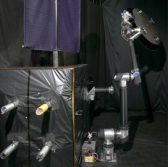 NASA has completed an initial ground demonstration of a robotic system designed to autonomously assemble satellites and space infrastructure components in orbit.
NASA has completed an initial ground demonstration of a robotic system designed to autonomously assemble satellites and space infrastructure components in orbit.
The space agency said Wednesday that the Dragonfly system was used to install and reconfigure large antenna reflectors on a simulated geostationary satellite.
Dragonfly is equipped with a robotic arm that will work to clamp down, carry and operate items in space as well as to assemble a massive satellite that cannot be launched in its final flight-ready state.
Space Systems Loral has secured additional contract funds from NASA to help the agency advance the design of the robotic self-assembly platform.
SSL will team up with MacDonald, Dettwiler and Associates and Tethers Unlimited to build the Dragonfly in-orbit satellite assembly system as part of a Tipping Point public-private partnership.
The Dragonfly Technology Demonstration Mission is one of three NASA missions that aim to assess current technologies’ capacity to support future flight demonstrations and potential exploration missions.
Al Tadros, vice president of space infrastructure and civil space at SSL, said the technology demonstration held in August represents a step towards overhauling in-orbit satellite management.
Trudy Kortes, TDM program executive at NASA, said that transformative technologies such as Dragonfly support efforts to build longer-lasting satellites, probes and other space hardware.
The project will also utilize additive manufacturing techniques meant to automatically produce antennae and replacement reflectors in space.




